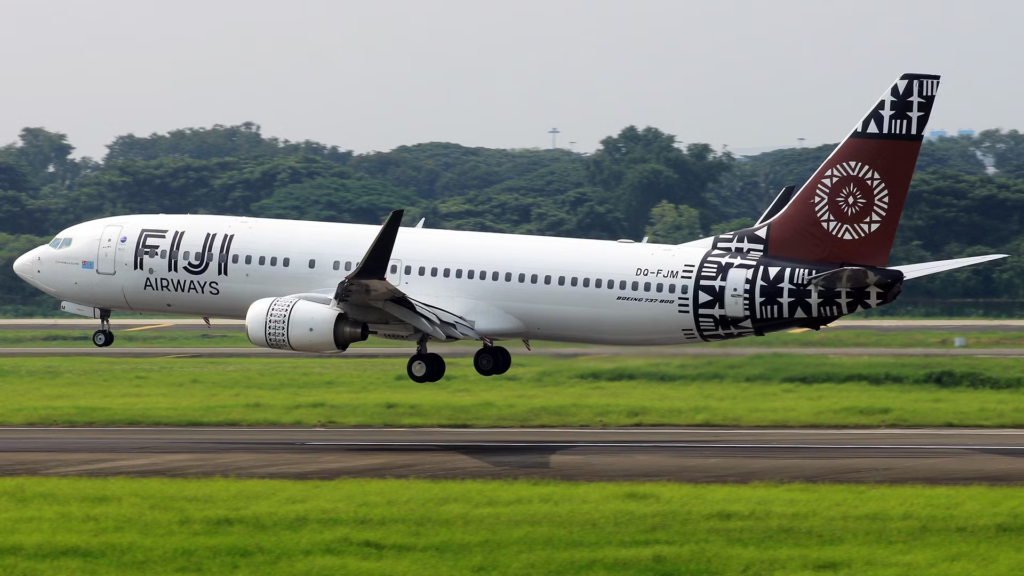A Fiji Airways flight on Thursday, October 9, ended up circling the skies of Mid Canterbury after the Boeing 737-800 experienced a bird strike on departure. Fiji Airways flight 450 had departed from Christchurch Airport for the nearly four-hour journey to Nadi Airport, Fiji, when the 737-800 hit a flock of birds on departure, forcing the airplane to circle the airport for two hours to burn fuel before declaring an emergency landing.
The 170 passengers and six crew onboard landed back in Christchurch safely and were met by emergency services on landing. The aircraft remained on the airport apron overnight, with a dent in its nose and markings of bird blood on the engine.
A ‘Substantial’ Flock Of Birds
Looking at the data from Flightradar24, the airplane had departed from the South Island of New Zealand’s largest airport, Christchurch International (CHC), at 14:24, some 19 minutes behind the scheduled departure time of 14:05. The plane, a Boeing 737-800 bearing registration DQ-FJN (MSN 34969), took off from the airports northerly runway, towards Fiji, however within seconds of ascent, the airplane struck a ‘substancial flock of birds’ according to Radio New Zealand.
Within two minutes of ascent, the aircraft appears to have turned south, to consider a return to the Garden City; however needed to burn fuel before being able to safely land back in Christchurch. Reviewing flight data, it is evident that the airline circled above towns in Mid Canterbury for approximately two hours before comfortably being able to land back at Christchurch.
It remains unclear if New Zealand’s Civil Aviation Authority will launch a formal investigation, with a CAA spokesperson noting it would await the airline’s formal report for review before taking any further action.
DQ-FJN Returns To Fiji
Once passengers disembarked the aircraft, there were reports of some being mildly shaken and dizzy from circling above the country, but they were in good spirits and reaccommodated onto a replacement flight the next day.
DQ-FJN remained on the apron at Christchurch overnight for technicians on the ground to check to ensure the airworthiness of the airplane. The aircraft has since returned to Nadi as FJ2450 on Friday, October 10, and is expected to return to regular services the next day. The airplane is currently scheduled to operate as FJ951 to Australia’s capital, Canberra, on Saturday, October 11 at 09:15.
Figures from the CAA identified that Christchurch is the most frequent airport to experience a bird strike when compared to airports around the country. With 54 strikes reported last year, however, this is relatively rare when compared to other airports around the world. On average, in New Zealand, there are around 1,500 reported strikes per year, or four strikes within every 10,000 aircraft movements.
Fiji Airways New Zealand & Australian Operations
Since being reborn as Fiji Airways, from Air Pacific, the Nadi-based carrier has pushed the envelope on ways that people can travel between Oceania to Fiji and beyond. The airline operates a fleet of narrow-body Boeing 737-800 and 737 MAX 8 aircraft, and Airbus A330-200, A330-300, and A350-900 widebody aircraft, providing frequent services between Australia and New Zealand’s major cities, and Nadi International Airport (NAN). Its regional flights are operated through its subsidiary, Fiji Link. The airline is part of the Oneworld Alliance, and frequent fliers can earn and redeem miles through the American Airlines AAdvantage Programme.
In New Zealand, Fiji Airways connects Nadi to Auckland with multiple daily flights, with several services a week also serving Wellington and Christchurch. Across the ditch, Fiji Airways operates to six Australian gateways, including Sydney, Brisbane, and Melbourne, with daily departures, while Adelaide, Cairns, and Canberra also welcome multiple services a week.
From Nadi, passengers can connect to the airline’s wider South Pacific network, stretching as far as Samoa, Tonga, Kiribati, Solomon Islands, New Caledonia, Tuvalu, and Vanuatu, or board a long-haul service to the airlines North American network, including Los Angeles, San Francisco, and Dallas/Fort Worth in the United States, or Vancouver, Canada, which sees the airline market itself heavily in the region for convenient one-stop itineraries to North America. The airline also operates to three Asian gateways, including Singapore, Hong Kong, and Tokyo Narita.






